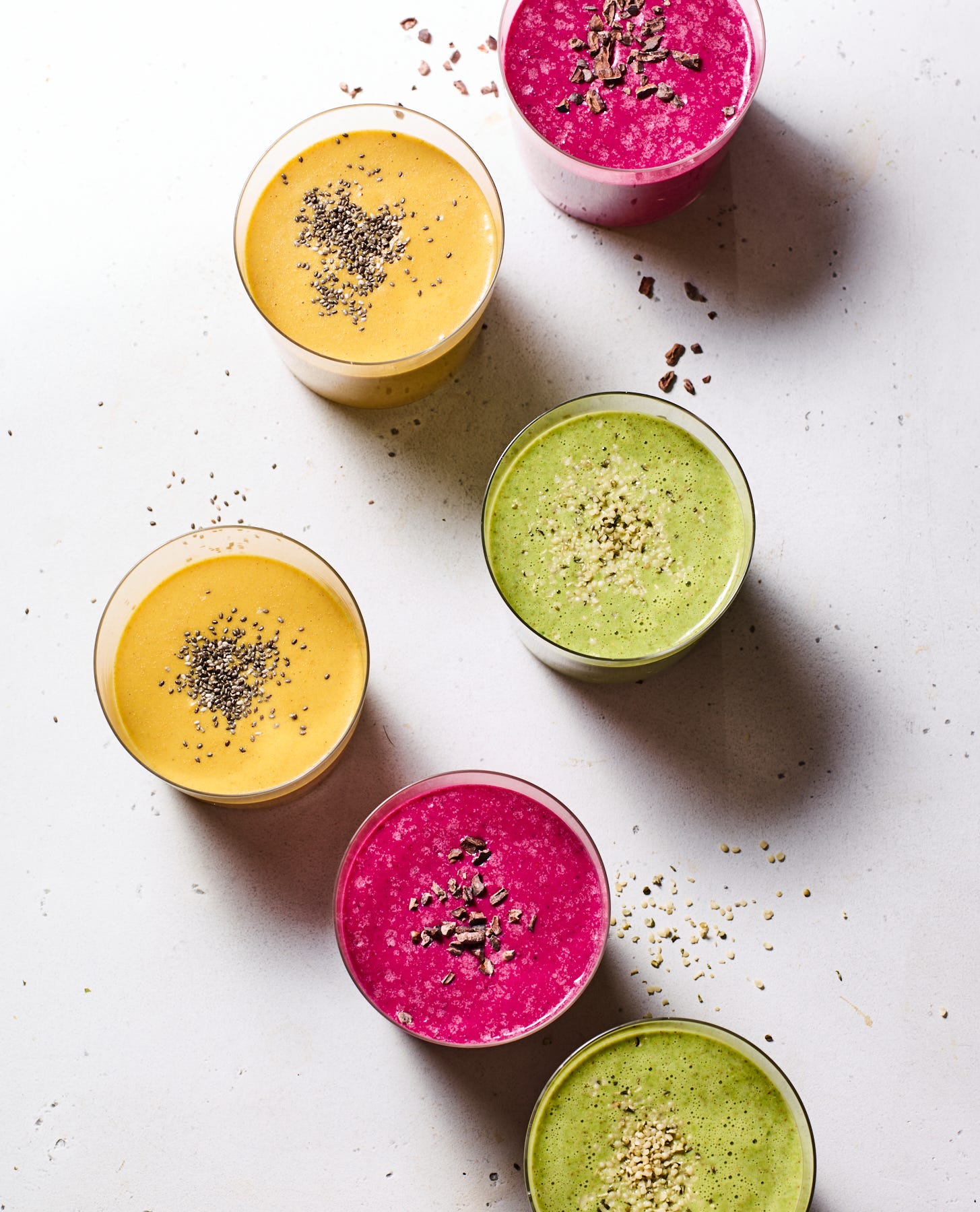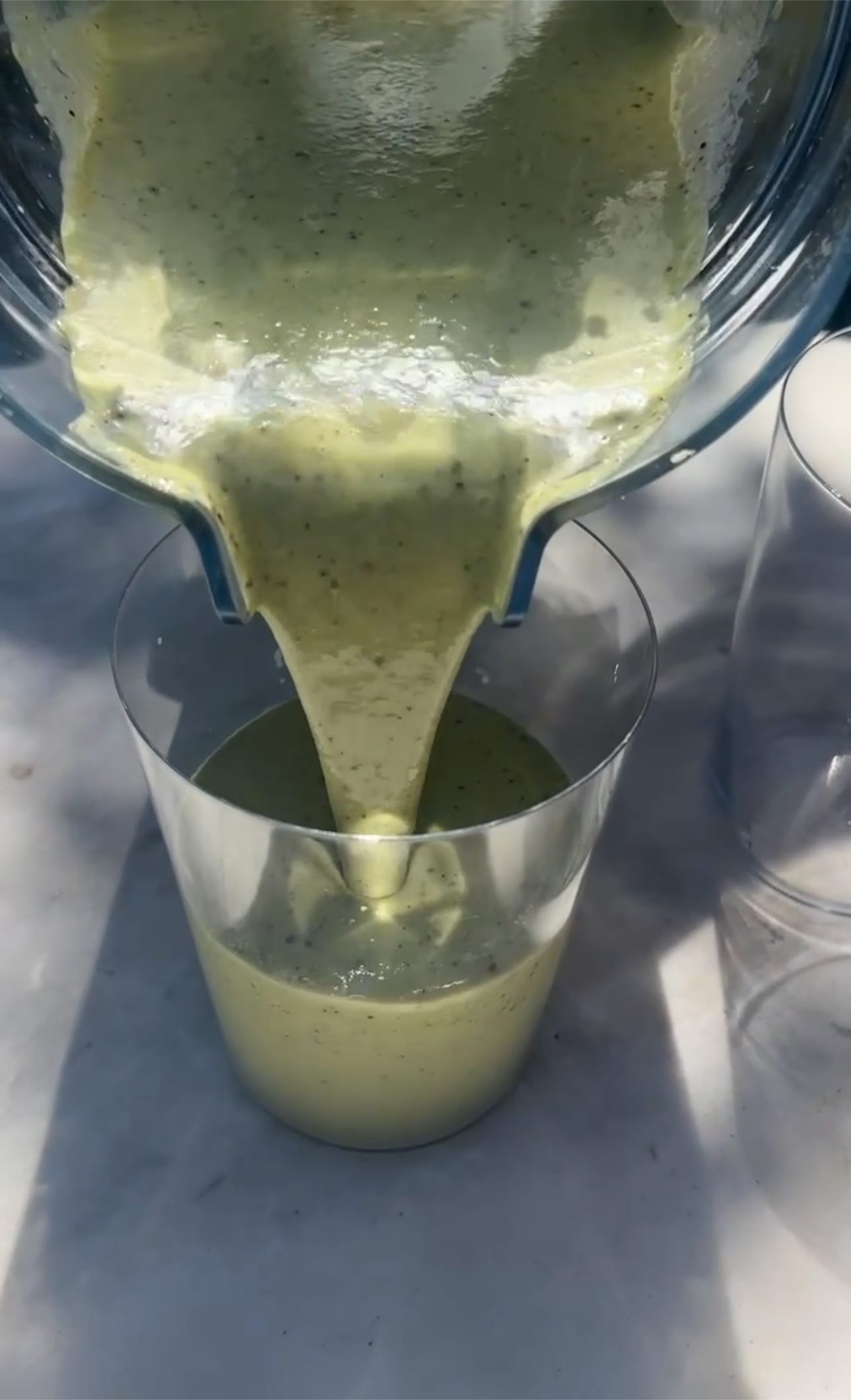Smoothie Time, Groovy Time
Plus over 40 high-protein, blood sugar-balancing ideas!
Today we’re going deep on how to make a great smoothie at home, what to order when you’re getting one on-the-go, a basic formula to follow, and a lot of recipe ideas (over 40!). If somehow you landed here and you’re not a subscriber, or you feel like upgrading your subscription for full access to this content and our Sunday meal prep recipes, here’s how:
Smoothies can be a delicious (and highly efficient) way to get all the nutrients you need to start your day. If not made correctly, they can also be loaded with sugar and lacking in nutrition. Whether that first meal is at 7am or 12pm (more information on timing of meals here), your initial bite is critical as it sets the tone for your blood sugar, mood, energy levels, and food choices throughout the day.
Ideally, you would “break your fast” with a meal that provides the following:
Optimal macronutrient ratios to balance blood sugar and provide stable energy levels.
Sufficient protein to keep you full and satisfied until lunch.
Fiber for satiety and digestion, and to get a head start on those daily fiber goals.
A serving of vegetables (and/or antioxidant-rich fruit like berries) to jumpstart micronutrient (vitamins, minerals, antioxidants, and phytonutrients) intake.
Healthy fats for energy, satiety, and focus.
A smoothie is certainly not the only option that fits this description (remember when I posted 100 breakfast options?), but it’s an easy way to get it all in.
Before we get into it, let’s make one thing clear: not all smoothies were blended equally. It’s really easy for this all-in-one meal to turn into a total sugar bomb. Here are some common culprits:
Dates: One date has around 16 grams of sugar.
Fruit juice: Fruit juice is high in sugar and very low in fiber.
Too much fruit: I often see a smoothie with banana, strawberries, pineapple, and mango (or something like that). I love fruit and will never tell you that it’s “unhealthy” but if you have that much fruit in a smoothie your blood sugar will likely spike.
Oat milk and other sweetened milks: Oat milk (while generally not sweetened) is a juiced grain so it’s very high in carbohydrates. Other nondairy milks might have added sugar as well.
Not enough protein, fiber, or fat to balance out the sugar: We need protein, fiber, and fat to help balance out any sugars/carbs and keep up full and satisfied.
With this in mind, here are the building blocks of a nutrient-rich, blood sugar-balancing smoothie:
1. Protein
Are you shocked that this is the first thing mentioned here? Protein is the most satiating macronutrient and will help provide sustained energy. In your smoothie, this can come from a protein powder or unsweetened Greek yogurt (make sure it’s a good portion — at least, and I mean at least, a serving, likely more). If you need more protein, you could use both! I’ve also heard of people adding cottage cheese to their smoothies, but there’s something about this that I can’t bring myself to try. On top of your base, nuts, seeds, edamame beans, or a higher protein milk (like dairy if you can tolerate it, soy, or a nut milk) will add extra protein.
2. Fiber
Fiber is critical for digestion and blood sugar management, and makes you feel fuller longer. Aim for at least 5-10 grams of fiber in your smoothie, which you can get from sources like avocado, chia seeds, basil seeds (I’m obsessed with these!), cacao nibs, hemp seeds, flax seeds, berries, and other fruits and vegetables. Here is a list of high fiber foods.
3. Healthy fats
Fats are important for energy production and cellular function. They play a key role in the absorption of fat-soluble nutrients and the production of certain hormones. Like protein and fiber, they also contribute to satiety. Healthy fat sources include nuts, seeds, coconut, or avocado. Some of my favorite milks, like Three Trees and Malk, are also higher in fat, and you’ll also get some fat from any seeds you use (chia, basil, flax, etc.).
4. Micronutrient-rich plants
Kickstart your day with a serving of vegetables (and, perhaps, antioxidant-rich fruit like berries). Greens like spinach and kale mix effortlessly and tastelessly into a variety of smoothies, zucchini and cauliflower lend a nice creamy texture, and cucumber is very refreshing and hydrating.
Note: There might be some overlap here (i.e. chia seeds are a great source of fiber, fat, and add some protein, and avocado has fat, fiber, and a nutrient-rich plant). That’s fine. Just make sure you have something from each category, and don’t overthink it. These are all healthy ingredients.
THE ESSENTIAL SMOOTHIE FORMULA
Think of this like a choose-your-own-adventure. But if that’s not your thing, don’t worry, I have specific ideas listed later in this post.
Protein
Choose a protein powder or greek yogurt protein base
+
A vegetables
A handful of greens like spinach or kale, cauliflower, zucchini, cucumber, etc.
+
Fiber
1 tablespoon of chia, hemp, flax, basil seeds, cacao nibs, etc.
+
Fat
1/4 avocado, 1 tablespoon nut or seed butter
+
Liquid
1 1/2 - 2 cups of dairy or dairy-free milk or water (or a combination of the two)
+
Optional additions
- Fruit: 1/4-1/2 cup of fresh or frozen fruit or 1/4-1/2 a banana (berries are my favorite because they’re high in antioxidants and fiber, and low in sugar)
- Herbs and spices: I love basil, mint, cinnamon, turmeric, ginger, and cardamom.
- Ice: I rarely add ice, but I know some people prefer adding ice to their smoothies. Most of the time, I will do frozen fruit instead.
- Something crunchy on top: Chewing can help with satiety, so add some cacao nibs, a little granola, some pumpkin seeds, shredded coconut flakes, a little bit of your favorite cereal, or something else crunchy on top to give you something to chew.
Instructions
Blend and serve!
A note about temperatures:
Smoothies are often thought of as a frozen beverage, but they don’t have to be. You can use room temperature ingredients (i.e. not from the freezer) or even warm the liquid before you blend. I’ve noted some warm smoothie ideas in the recipe/idea list below.
HOW TO ORDER A SMOOTHIE OUT
Even at the “healthiest” places, blood sugar balancing is often not a priority. Make modifications to mimic this formula and look out for the following:
Juice: Swap fruit juices for water or milk (dairy or nondairy)
Fruit: if there are multiple fruits listed in the description ask for just 1.
Ditch the dates. Most smoothies with dates also have fruit. The fruit should be enough to sweeten it.
Make sure there’s a protein in there: Add it if you need to.
Add something green: There’s often an option to add greens, so ask for a handful.
Some key words to look for when ordering: Keto*, High Protein, Strength, Muscle.
*Keto is not a diet I recommend very often, but it’s often used as a marketing term to mean low carb and high protein.
SMOOTHIE TOOLS & ACCESSORIES
Here are a few products I love for making smoothies.
Blenders
I like these smaller blenders like Beast and OurPlace for smoothies, or would consider a glass blender like these from Oster and KitchenAid.Drinking vessel
Okay this is by far the chicest smoothie glass I’ve ever seen. I love that it has a lid so you could keep it in the fridge. If you want to bring to work or make at night for the next day (a great idea if your mornings are hectic or rushed), having something portable with a lid like this is great.Pre-portioned freezer packs
Get your smoothies prepped ahead of time with these silicon trays. You can pre-portion any fruit, vegetables, seeds, nuts, etc. When you’re ready to blend, just pop them out, add extra liquid and protein and blend. Like your very own Daily Harvest.
SMOOTHIE IDEAS
Finally we got to the good part! Here is an exhaustive list of flavor combinations you could try! If you have others that you love, please add them in the comments below.
Before we get into, a couple of notes:
Yogurt: If using as protein source, I normally do nonfat Greek yogurt, because we’re adding more fats in (read below). If the yogurt is dairy free, it does not have protein.
Chocolate: For chocolate flavored smoothies, I prefer to use vanilla protein + cacao powder over chocolate protein.
Cauliflower rice: Frozen cauliflower rice is a really easy (and completely tasteless) way to get a veggie in your smoothie. You’ll see this referenced a few times, so thought I would explain.




